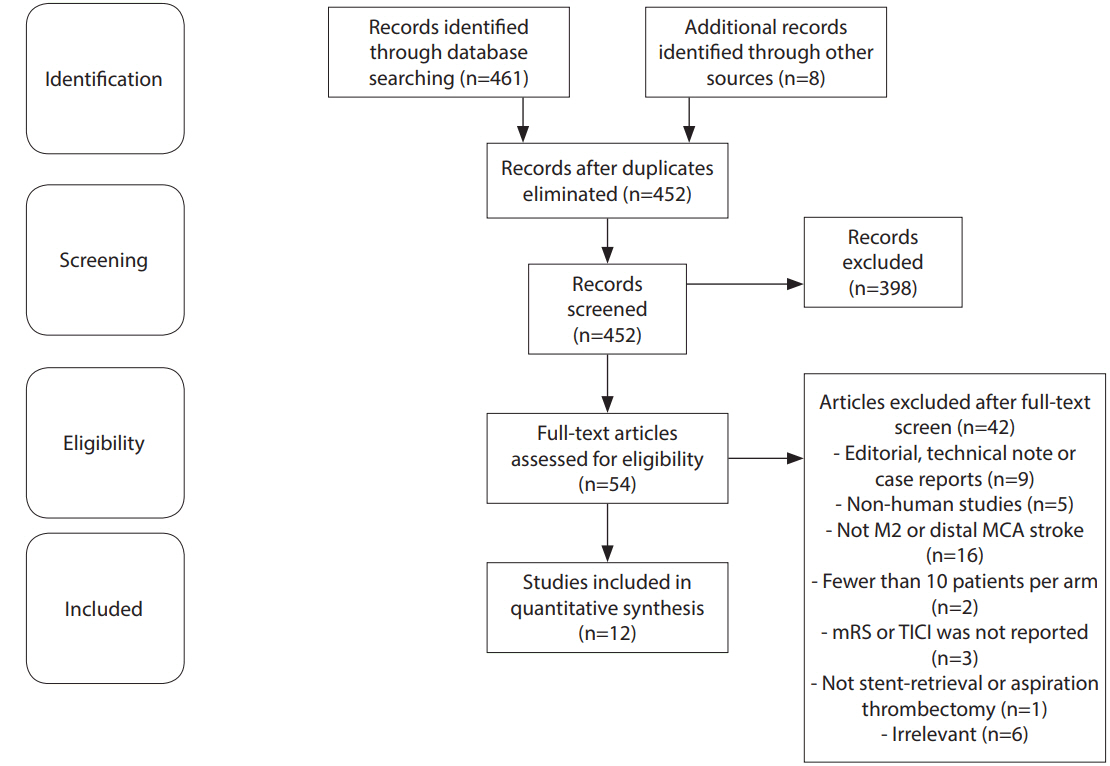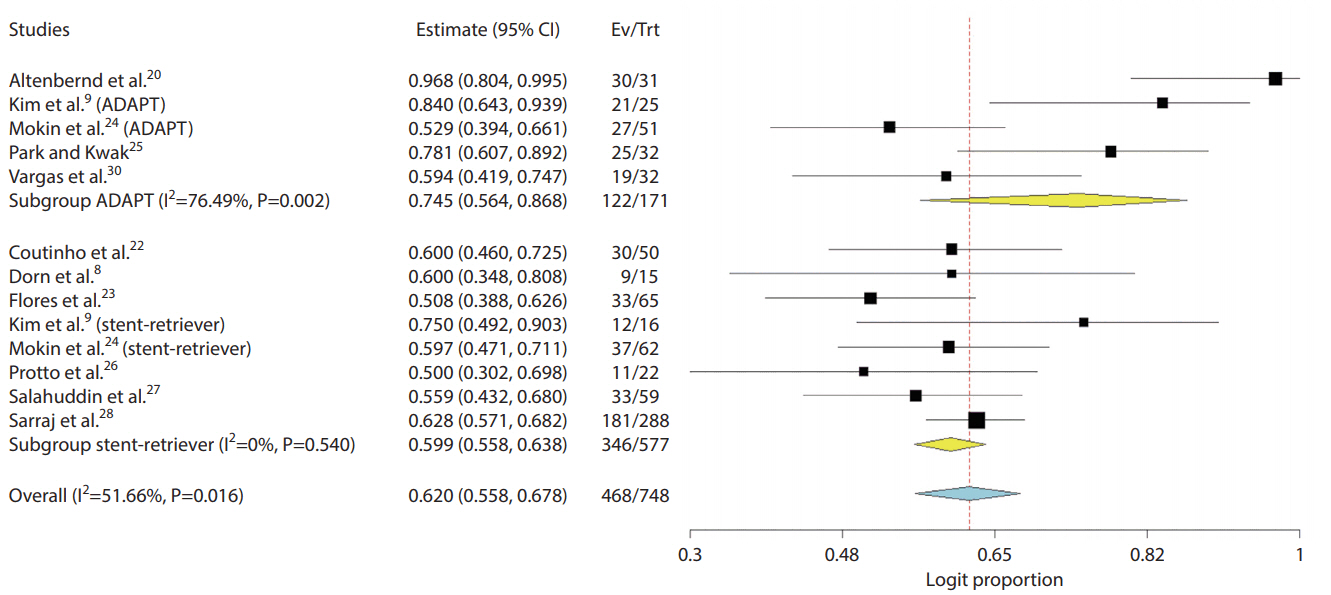Neurointervention.
2018 Sep;13(2):100-109. 10.5469/neuroint.2018.00997.
Contact Aspiration versus Stent-Retriever Thrombectomy for Distal Middle Cerebral Artery Occlusions in Acute Ischemic Stroke: Meta-Analysis
- Affiliations
-
- 1NeuroSpine Surgery Research Group, Prince of Wales Private Hospital, Randwick, Australia.
- 2Department of Neurosurgery, Prince of Wales Hospital, Randwick, Australia.
- 3Interventional Neuroradiology Service, Department of Radiology, Austin Hospital, Heidelberg, Australia. asadi.hamed@gmail.com
- 4Department of Radiology, School of Medicine, Faculty of Health, Deakin University, Waurn Ponds, Australia.
- 5Department of Interventional Radiology, Guy's and St Thomas' NHS Foundation Trust, London, UK.
- 6Department of Radiology, University of Toronto, Toronto, Canada.
- 7Interventional Neuroradiology Unit, Monash Imaging, Monash Health, Clayton, Australia.
- 8Stroke Division, Florey Institute of Neuroscience and Mental Health, University of Melbourne, Parkville, Australia.
- 9Department of Neurology, Austin Health, Heidelberg, Australia.
- KMID: 2424058
- DOI: http://doi.org/10.5469/neuroint.2018.00997
Abstract
- PURPOSE
The evidence for endovascular therapy and choice of technique in distal middle cerebral artery (MCA) M2 segment occlusions in acute ischemic stroke remains controversial. We aimed to conduct a systematic review and meta-analysis primarily comparing reperfusion rates of stent-retrieval versus contact aspiration for M2 occlusions.
MATERIALS AND METHODS
Study selection included cohorts of patients with distal MCA occlusions in acute ischemic strokes treated with an endovascular approach including stent-retrieval or contact aspiration. Twelve studies were selected for meta-analysis for a total of 835 cases. Meta-analysis by proportions was conducted on parameters including baseline and procedural characteristics, thrombolysis in cerebral infarction (TICI) 2b-3 outcomes, and 90-day modified Rankin scale (mRS) outcomes.
RESULTS
Hypertension and hyperlipidemia were more prevalent in stent-retriever patients. Pooled baseline National Institute of Health Stroke Scale scores and Alberta Stroke Program Early Computed Tomography Score imaging scores were similar. Pooled time onset of symptoms to door arrival was higher for the stent-retrieval group (154 vs. 97.4 minutes, P=0.01), as was time to groin puncture (259.9 vs. 156.2 minutes, P=0.02), but there was no difference in procedure time. The TICI 2b-3 recanalization rate was similar (80.5% vs. 86.8%, P=0.168). The frequency of mRS 0-2 at 90-day was also similar (74.5% vs. 59.9%, P=0.120), and an excellent mRS 0-1 was lower for stent-retrievers (39.9% vs. 65.6%, P=0.003). A significant negative correlation was found between onset to groin puncture time and the proportion of patients with a good mRS (r=-0.71, P=0.048).
CONCLUSION
Both endovascular techniques achieved recanalization rates greater than 80% and 90-day outcomes of minimal disability with similar complication rates. The literature is skewed by aspiration cases being performed sooner after onset of stroke compared to stent-retriever cases.
Keyword
MeSH Terms
Figure
Reference
-
1. Berkhemer OA, Fransen PS, Beumer D, van den Berg LA, Lingsma HF, Yoo AJ, et al. A randomized trial of intraarterial treatment for acute ischemic stroke. N Engl J Med. 2015; 372:11–20.2. Campbell BC, Mitchell PJ, Kleinig TJ, Dewey HM, Churilov L, Yassi N, et al. Endovascular therapy for ischemic stroke with perfusion-imaging selection. N Engl J Med. 2015; 372:1009–1018.
Article3. Goyal M, Demchuk AM, Menon BK, Eesa M, Rempel JL, Thornton J, et al. Randomized assessment of rapid endovascular treatment of ischemic stroke. N Engl J Med. 2015; 372:1019–1030.4. Jovin TG, Chamorro A, Cobo E, de Miquel MA, Molina CA, Rovira A, et al. Thrombectomy within 8 hours after symptom onset in ischemic stroke. N Engl J Med. 2015; 372:2296–2306.
Article5. Saver JL, Goyal M, Bonafe A, Diener HC, Levy EI, Pereira VM, et al. Stent-retriever thrombectomy after intravenous t-PA vs. t-PA alone in stroke. N Engl J Med. 2015; 372:2285–2295.
Article6. Goyal M, Menon BK, van Zwam WH, Dippel DW, Mitchell PJ, Demchuk AM, et al. Endovascular thrombectomy after large-vessel ischaemic stroke: a meta-analysis of individual patient data from five randomised trials. Lancet. 2016; 387:1723–1731.
Article7. Phan K, Zhao DF, Phan S, Huo YR, Mobbs RJ, Rao PJ, et al. Endovascular therapy including thrombectomy for acute ischemic stroke: a systematic review and meta-analysis with trial sequential analysis. J Clin Neurosci. 2016; 29:38–45.
Article8. Dorn F, Lockau H, Stetefeld H, Kabbasch C, Kraus B, Dohmen C, et al. Mechanical thrombectomy of M2-occlusion. J Stroke Cerebrovasc Dis. 2015; 24:1465–1470.
Article9. Kim YW, Son S, Kang DH, Hwang YH, Kim YS. Endovascular thrombectomy for M2 occlusions: comparison between forced arterial suction thrombectomy and stent retriever thrombectomy. J Neurointerv Surg. 2017; 9:626–630.
Article10. Powers WJ, Derdeyn CP, Biller J, Coffey CS, Hoh BL, Jauch EC, et al. 2015 American Heart Association/American Stroke Association focused update of the 2013 guidelines for the early management of patients with acute ischemic stroke regarding endovascular treatment: a guideline for healthcare professionals from the American Heart Association/American Stroke Association. Stroke. 2015; 46:3020–3035.
Article11. Phan K, Dmytriw AA, Teng I, Moore JM, Griessenauer C, Ogilvy C, et al. A direct aspiration first pass technique vs standard endovascular therapy for acute stroke: a systematic review and meta-analysis. Neurosurgery. 2018; 83:19–28.
Article12. Turk AS, Frei D, Fiorella D, Mocco J, Baxter B, Siddiqui A, et al. ADAPT FAST study: a direct aspiration first pass technique for acute stroke thrombectomy. J Neurointerv Surg. 2014; 6:260–264.
Article13. Turk AS, Spiotta A, Frei D, Mocco J, Baxter B, Fiorella D, et al. Initial clinical experience with the ADAPT technique: a direct aspiration first pass technique for stroke thrombectomy. J Neurointerv Surgery. 2014; 6:231–237.
Article14. Turk AS, Turner R, Spiotta A, Vargas J, Holmstedt C, Ozark S, et al. Comparison of endovascular treatment approaches for acute ischemic stroke: cost effectiveness, technical success, and clinical outcomes. J Neurointerv Surg. 2015; 7:666–670.
Article15. Chen CJ, Wang C, Buell TJ, Ding D, Raper DM, Ironside N, et al. Endovascular mechanical thrombectomy for acute middle cerebral artery M2 segment occlusion: a systematic review. World Neurosurg. 2017; 107:684–691.
Article16. Moher D, Liberati A, Tetzlaff J, Altman DG; PRISMA Group. Preferred reporting items for systematic reviews and meta-analyses: the PRISMA statement. PLoS Med. 2009; 6:e1000097.
Article17. Higashida RT, Furlan AJ, Roberts H, Tomsick T, Connors B, Barr J, et al. Trial design and reporting standards for intra-arterial cerebral thrombolysis for acute ischemic stroke. Stroke. 2003; 34:e109–e137.
Article18. Hozo SP, Djulbegovic B, Hozo I. Estimating the mean and variance from the median, range, and the size of a sample. BMC Med Res Methodol. 2005; 5:13.
Article19. Higgins JP, Thompson SG. Quantifying heterogeneity in a meta-analysis. Stat Med. 2002; 21:1539–1558.
Article20. Altenbernd J, Kuhnt O, Hennigs S, Hilker R, Loehr C. Frontline ADAPT therapy to treat patients with symptomatic M2 and M3 occlusions in acute ischemic stroke: initial experience with the penumbra ACE and 3MAX reperfusion system. J Neurointerv Surg. 2017; 10:434–439.
Article21. Lapergue B, Blanc R, Gory B, Labreuche J, Duhamel A, Marnat G, et al. Effect of endovascular contact aspiration vs stent retriever on revascularization in patients with acute ischemic stroke and large vessel occlusion: the ASTER randomized clinical trial. JAMA. 2017; 318:443–452.
Article22. Coutinho JM, Liebeskind DS, Slater LA, Nogueira RG, Baxter BW, Levy EI, et al. Mechanical thrombectomy for isolated M2 occlusions: a post hoc analysis of the STAR, SWIFT, and SWIFT PRIME studies. AJNR Am J Neuroradiol. 2016; 37:667–672.
Article23. Flores A, Tomasello A, Cardona P, de Miquel MA, Gomis M, Garcia Bermejo P, et al. Endovascular treatment for M2 occlusions in the era of stentrievers: a descriptive multicenter experience. J Neurointerv Surg. 2015; 7:234–237.
Article24. Mokin M, Primiani CT, Ren Z, Kan P, Duckworth E, Turner RD 4th, et al. Endovascular treatment of middle cerebral artery M2 occlusion strokes: clinical and procedural predictors of outcomes. Neurosurgery. 2017; 81:795–802.
Article25. Park JS, Kwak HS. Manual aspiration thrombectomy using penumbra catheter in patients with acute M2 occlusion : a single-center analysis. J Korean Neurosurg Soc. 2016; 59:352–356.
Article26. Protto S, Sillanpää N, Pienimäki JP, Matkaselkä I, Seppänen J, Numminen H. Stent retriever thrombectomy in different thrombus locations of anterior cerebral circulation. Cardiovasc Intervent Radiol. 2016; 39:988–993.
Article27. Salahuddin H, Ramaiah G, Slawski DE, Shawver J, Buehler M, Zaidi SF, et al. Mechanical thrombectomy of M1 and M2 middle cerebral artery occlusions. J Neurointerv Surg. 2018; 10:330–334.
Article28. Sarraj A, Sangha N, Hussain MS, Wisco D, Vora N, Elijovich L, et al. Endovascular therapy for acute ischemic stroke with occlusion of the middle cerebral artery M2 segment. JAMA Neurol. 2016; 73:1291–1296.
Article29. Tomsick TA, Carrozzella J, Foster L, Hill MD, von Kummer R, Goyal M, et al. Endovascular therapy of M2 occlusion in IMS III: role of M2 segment definition and location on clinical and revascularization outcomes. AJNR Am J Neuroradiol. 2017; 38:84–89.
Article30. Vargas J, Spiotta AM, Fargen K, Turner RD, Chaudry I, Turk A. Experience with a direct aspiration first pass technique (ADAPT) for thrombectomy in distal cerebral artery occlusions causing acute ischemic stroke. World Neurosurg. 2017; 99:31–36.
Article31. Hernández-Pérez M, Pérez de la Ossa N, Aleu A, Millán M, Gomis M, Dorado L, et al. Natural history of acute stroke due to occlusion of the middle cerebral artery and intracranial internal carotid artery. J Neuroimaging. 2014; 24:354–358.
Article32. Lima FO, Furie KL, Silva GS, Lev MH, Camargo EC, Singhal AB, et al. Prognosis of untreated strokes due to anterior circulation proximal intracranial arterial occlusions detected by use of computed tomography angiography. JAMA Neurol. 2014; 71:151–157.
Article
- Full Text Links
- Actions
-
Cited
- CITED
-
- Close
- Share
- Similar articles
-
- Successful Cross-circulation Stent-Retriever Embolectomy Through Posterior Communicating Artery for Acute MCA Occlusion by Using Trevo XP ProVue
- Delayed Rupture of an Anterior Communicating Artery Pseudoaneurysm Caused by Distal Occlusion Thrombectomy Using a Stent Retriever: A Case Report and Mechanism of Injury
- The Limitations of Thrombectomy with Solitaire(TM) AB as First-line Treatment in Acute Ischemic Stroke: A Single Center Experience
- Successful Mechanical Thrombectomy in a 2-Year-Old Male Through a 4-French Guide Catheter
- Adjuvant Tirofiban Injection Through Deployed Solitaire Stent As a Rescue Technique After failed Mechanical Thrombectomy in Acute Stroke






